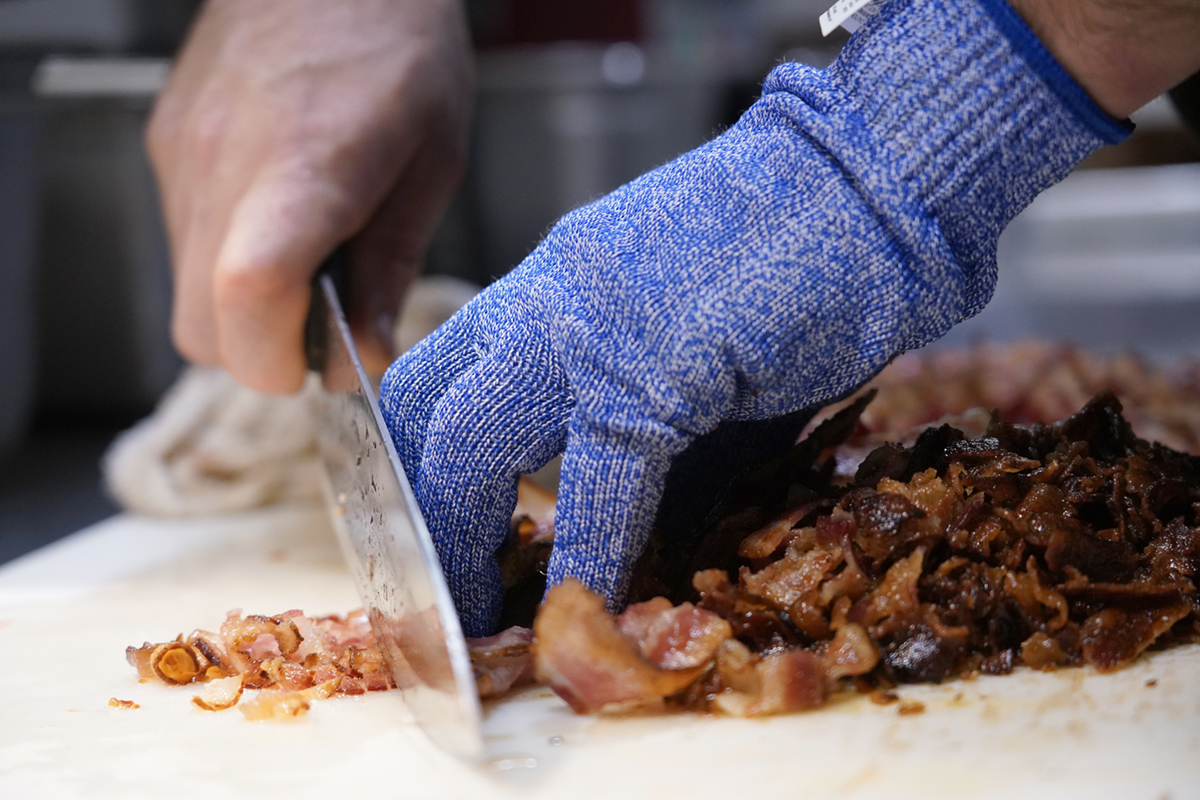Cut Resistance – the basics
The Right Cut Resistant Protection Makes a Difference
- Never perform informal cut resistance testing with a shop knife or pocket knife!
- Placing a glove on a hard surface and cutting it with a knife is not an accurate measurement of cut resistance. Hard surfaces like a desk or a workbench will help hold the individual fibers of the knitted glove in place and allow the blade to initiate a cut.
- Cut resistant gloves are designed for incidental cuts and slashes to the hand. When wearing a glove, the fibers/yarns that comprise the knitted shell are cushioned by your hand and it is more difficult for a blade to initiate a cut. In addition, fibers in the knitted gloves will roll with the knife blade to displace the force of the cut.
Cut resistant gloves and sleeves are designed to protect hands from direct contact with sharp objects such as glass and metal. The level of cut resistance provided is a combination of material composition and weight. Cut protection is improved by increasing its material weight by using high-performance materials such as Spectra or Dyneema, or by using composite yarns by combining stainless steel, fiberglass, synthetic yarns and high-performance yarns.
Lightweight gloves are usually more flexible, while heavier weight gloves generally offer more cut and abrasion protection.
Performance of a glove can also be a affected by coatings applied to the surface which can also o er enhanced grip.
Cut Resistant Fibers
HPPE: High performance Polyethylene (HPPE) fibers offer maximum strength with minimum weight. HPPE is 10 times stronger than steel by weight as well as 40% stronger than aramid fibers offering a softer, cooler alternative. HPPE is flexible, tactile and durable.
Spectra: A polyethylene ber that is 10 times tougher than steel per unit weight o ering high cut resistance even when wet. Its low lint and exible nature make it ideal for use in food processing.
Dyneema Fiber: Super-strong fiber made from Ultra-High Molecular-Weight Polyethylene that is 15x stronger than steel and 40% stronger than other aramid fibers (per unit weight). Developed in Europe, Dyneema is a lightweight and natural-feeling fiber. It has high tensile strength, is durable, highly hydrophobic and resistant to chemicals and UV light. Well suited for use in food preparation.Stainless Steel
Blended Shells: The introduction of steel and glass to HPPE and aramid help to significantly increase levels of cut protection while helping maintain comfort and fit.
Cut-Proof vs. Cut Resistant
Cut-proof gloves simply do NOT exist. All to often, gloves designed to be cut resistant are misinterpreted as being cut proof, giving wearers a false sense of security which can lead to risky and dangerous behaviors they would not normally perform.
Cuts and lacerations may not sound like a big deal for the average foodservice operation, but the numbers clearly paint a different picture.
Cut Resistance is the level of protection a cut resistant glove offers against blades, knives, sharp equipment edges, etc.
In choosing which cut resistant glove….
Measuring Cut Protection Performance
The development of standards to compare the performance of PPE products has significantly improved the ability to select appropriate PPE. Cut resistant levels are a way to categorize the toughness of the fibers and their ability to withstand contact with blades, slicers or sharp edges.
ANSI glove protection levels were established in 1999 and revised in 2005, 2011 and again in 2016 to reflect innovations and advancements in cut resistant materials.
ASTM 1790-05 tests to see the amount of pressure/load required to cut through the test glove material with a straight edged blade that moves along a straight path. This test is also known as the CPPT Test (Cut Protection Performance Test). This test method uses force-distance testers to determine how resistant a material is to cuts when exposed to a cutting edge under specific loads. This test method provides data to differentiate the cut-resistance of common material such as cotton, leather and high-performance fibers. Results are provided in terms of grams of weight applied to the specific material tested.
The EN388 Standard describes the Couptest method for cut resistance, where a circular blade is moving back and forth across the sample under a fixed load of 5N/500gr, while rotating in the opposite direction of the linear movement. This method simulates the number of repetitive cuts needed to cut through the fabric on the same position in the glove using a constant load. The result of this test, referred to as the cut index, tells you how much better the sample is compared to a reference cotton fabric.
Although there are no OSHA regulations specific to cut-resistant gloves, OSHA 1910.138(a) and 1910.138 (b) do pertain to hand protection: 1910.138(a)

